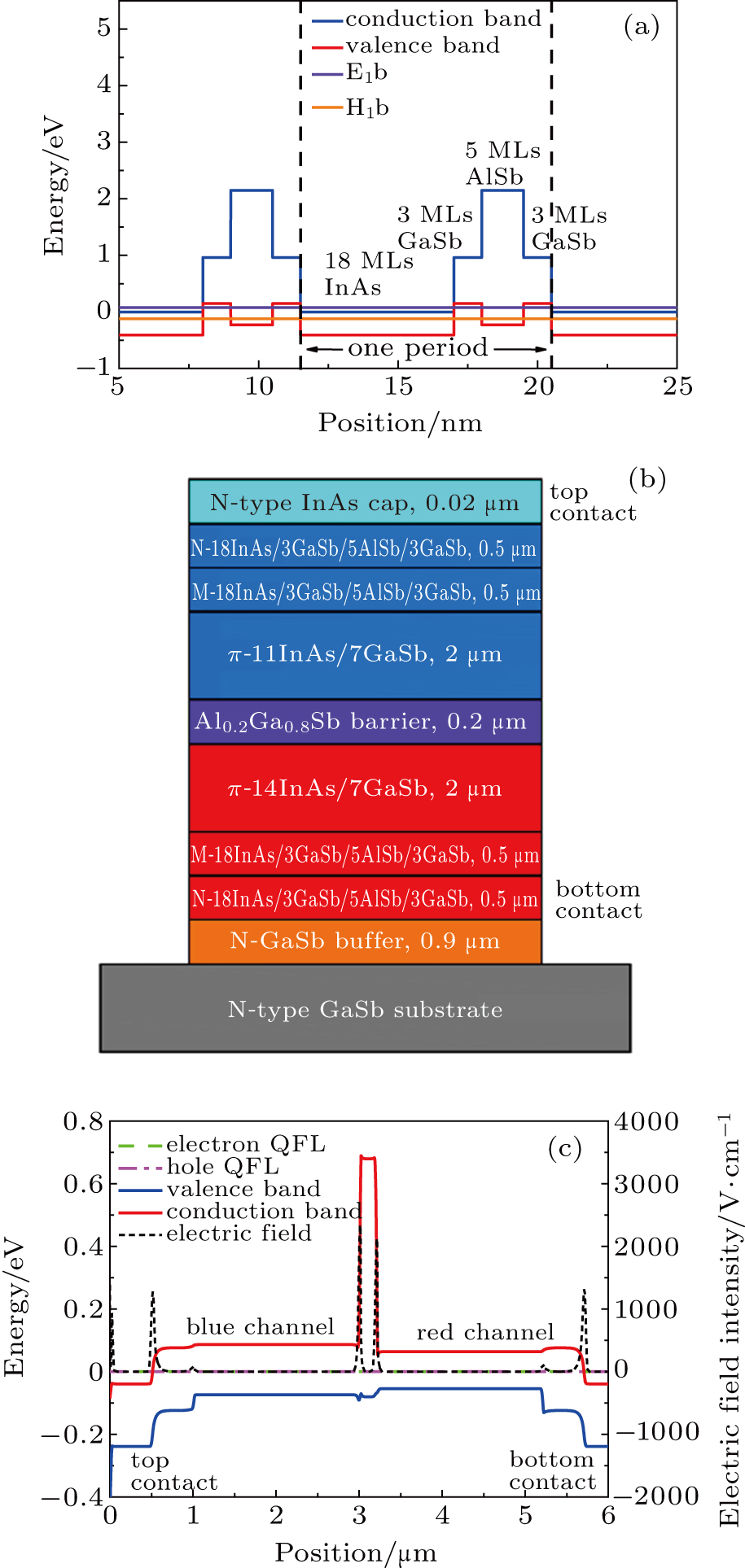† Corresponding author. E-mail:
Project supported by the National Key Technology R&D Program of China (Grant Nos. 2018YFA0209104 and 2016YFB0402403).
A long-/long-wave dual-color detector with N-M-π-B-π-M-N structure was developed based on a type-II InAs/GaSb superlattice. The saturated responsivity was achieved under low bias voltage for both channels. The device could be operated as a single detector for sequential detection and showed high quantum efficiencies. The peak quantum efficiencies of long-wavelength infrared band-1 (blue channel) and long-wavelength infrared band-2 (red channel) were 44% at 6.3 μm under 20 mV and 57% at 9.1 μm under −60 mV, respectively. The optical performance for each channel was achieved using a 2 μm thickness absorber. Due to the high QE, the specific detectivities of the blue and red channels reached 5.0 × 1011 cm·Hz1/2/W at 6.8 μm and 3.1 × 1011 cm·Hz1/2/W at 9.1 μm, respectively, at 77 K.
Type-II InAs/GaSb superlattices (T2SLs), first proposed by Sai-Halasz et al. in the 1970s,[1] offer an alternative means of infrared detection and imaging. Mercury-cadmium telluride (MCT) photodetectors have several issues: they are toxic, relatively costly, and can be inhomogeneous over large wafers. Long-wavelength infrared (LWIR) MCT photodetectors are often limited by Auger recombination, which T2SLs have been theorized to be able to suppress, which could potentially lead to better performance. Furthermore, T2SLs have already demonstrated high external quantum efficiencies (QEs) of up to 50% in the LWIR.[2] Infrared detectors with PπMN-structure[3,4] and unipolar barrier structure[5,6] have been developed. In those studies, T2SLs have shown flexibility in device structure design to improve the detector performance.[7–9] Multi-color/band detectors can contribute to enhancing image contrast or target recognition.[8–10] Detectors configured for LWIR/LWIR detection are used for clutter rejection in a wide variety of space and ground-based applications.[11,12]
In this work, a long-/long-wave dual-color detector with high QE based on an N-M-π-B-π-M-N structure was first developed. The blue and red channels with 50% cutoff wavelengths at 7.6 μm and 11.5 μm, respectively, presented QEs of 44% and 57% at 77 K. In the structure, the M-structure barrier was used to suppress the dark current. And in order to inhibit cross-talk, an Al0.2Ga0.8Sb layer was sandwiched between the blue and the red channels.
The band structure of the M-structure superlattice is shown in Fig.
The band alignment and distribution of electrical field intensity are shown in Fig.
The mismatch of each superlattice was measured using symmetric (004) x-ray diffraction. The high-resolution x-ray diffraction (HRXRD) pattern is shown in Fig.
 | Fig. 2. (a) HRXRD pattern, (b) differential interference micrograph, and (c) AFM image of the device. |
| Table 1. The mismatch, period, and FWHM of 0th peaks of different superlattices. . |
The mesas with different sizes (200 μm, 300 μm, 500 μm) were defined through lithography (SUSS MA6) and fabricated by dry etching through the InAs cap layer (top contact) and each region into the red channel N-type contact (bottom contact). The SiO2 hard etching mask (PECVD STS) and inductively coupled plasma (ICP OXFORD plasmalab System 100) system were chosen to etch the mesa. The sidewall was passivated using anodic sulfide, then covered by a 200 nm SiO2 layer. The SiO2 layer was deposited using ion beam sputtering (OXFORD optofab3000). After the above steps, a second photolithography and ICP were performed to open the window on the passivation layer. The final metal electrode was deposited using electron beam evaporation (SKY EB700-I).
The working mechanism is similar to that of the dual-band detector which was mentioned in Ref. [14]. The optical characterization of the front-side illuminated detector was performed at 77 K using a Fourier transform infrared (FTIR) spectrometer (Bruker Vertex70) and a calibrated black-body (SYSTEMS) source at a temperature of 500 °C. The FTIR spectrometer was calibrated by using a standard DTGS detector without anti-reflection (AR) coating. Figure
 |
 |




| Table 2. Comparison with published results. . |
The dark current density (J) was measured using Agilent B1500 in the bias range from 0.3 V to −0.3 V at 77 K. As shown in Fig.
Figure
In this work, a long-/long-wave dual-color detector based on an InAs/GaSb superlattice with N-M-π-B-π-M-N structure was successfully fabricated and characterized. The peak QEs of the blue and red channels are 44% at 6.3 μm under 20 mV and 57% at 9.1 μm under −60 mV, respectively. And the corresponding responsivities of the blue and red channels are 2.4 A/W at 6.8 μm and 4.2 A/W at 9.1 μm, respectively. The optical performance was measured based on a 2 μm thick absorber. The maximum D* for the blue channel is 5.0 × 1011 cm·Hz1/2/W at 6.8 μm without applied bias, while it is 3.1 × 1011 cm·Hz1/2/W at 9.1 μm under −60 mV for the red channel. In order to achieve better performance, the device structure and fabrication process of the dual-color detector both need to be further optimized.
| [1] | |
| [2] | |
| [3] | |
| [4] | |
| [5] | |
| [6] | |
| [7] | |
| [8] | |
| [9] | |
| [10] | |
| [11] | |
| [12] | |
| [13] | |
| [14] | |
| [15] | |
| [16] | |
| [17] |





